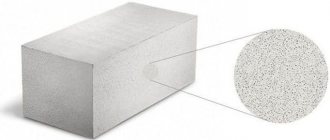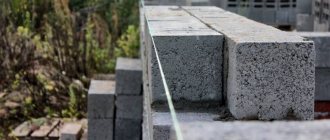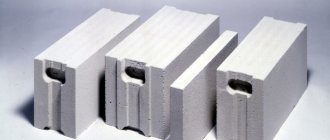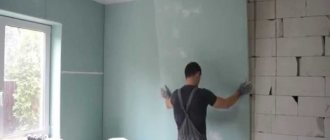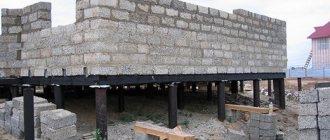Today, aerated concrete is very popular in construction. If you want to build a house from aerated concrete, you need to know the pros and cons of this material.
This article presents the advantages and disadvantages of this material, and briefly describes how you can build a house from aerated concrete with your own hands.
Aerated blocks have a porous structure and a low density.
The house can be built from different materials, including: aerated concrete, brick, wood. At the same time, only knowing all the advantages of each building material can you choose which one to use for building a house.
Today, one of the most popular materials in construction is aerated concrete. It is made from cement, sand and lime. Houses are easy and quick to build, which is why this material has become widespread and in demand.
1.Pros and cons of aerated concrete
Modern aerated concrete has many advantages, here are some of them.
Advantages of aerated concrete:
- High strength material. During the manufacturing process of autoclaved aerated concrete, it hardens in an autoclave under the influence of temperature and high pressure. It is under these conditions that low-basicity microscopic crystals of calcium hydrosilicate are formed, which impart strength to the material
- A light weight. The fact that the blocks are not heavy in enclosing structures means that there is less load on the base and frame of the object, which means, as a result, there will be lower costs for both the material and the foundation, which will entail a reduction in the overall costs of building the object.
- Excellent thermal insulation properties make it possible not to use additional thermal insulation materials in the wall construction. In addition, in winter there is an opportunity to save on heating costs.
- Excellent sound insulation properties. Walls built from aerated concrete can provide excellent sound insulation.
- Versatility. Aerated concrete can be freely sawed, sanded, drilled, thanks to which aerated concrete blocks can be given different shapes. They are used for walls, fireplaces, ceilings, steps, fences and other objects.
- Aerated blocks have precise geometric dimensions, which makes it possible to lay masonry using a special adhesive for aerated concrete with a seam thickness of up to 3 mm.
- Moisture resistance and frost resistance. Resistant to frost. In addition, due to the porosity of the material, water cannot quickly penetrate the material.
- Safe for health. Made from natural raw materials: lime, water and sand.
- Quality control. At the factories where blocks are made, there is a laboratory that carries out product quality control.
- Attaching to aerated concrete is quite simple using special anchors for aerated concrete.
Despite the fact that aerated concrete has a low density, houses made from it are quite strong and durable
Advantages of working with a construction company
Houses made of aerated blocks, the designs and prices of which have been agreed upon with the customer, are not inferior in comfort to their brick counterparts and are convenient for year-round living in areas with snowy and frosty winters. Cooperation with a construction company involves many pleasant nuances:
- the cost of construction is fixed in the contract and does not change anymore;
- if an organization undertakes construction, an individual architectural project is developed free of charge;
- the customer receives an estimate and legal documents drawn up by a lawyer in the relevant organizations;
- the company independently purchases materials; The work is carried out by masons, finishers, plumbers and gas welders with extensive practical experience.
House built by a construction company Source makemone.ru
Aerated concrete or brick - which is better?
In fact, one brick is thirteen times smaller in size than one gas block. The weight of an aerated block is three times that of a brick. It takes much less time to build a house from aerated blocks than to build a brick house.
What material to build a house from? This decision is exclusively for everyone. Let's consider several comparative characteristics of aerated concrete and brick:
- A good aerated block costs less than a brick. It is also worth noting that good brick is rare today.
- Brick has been around for about 500 years, but aerated concrete has been in construction for only 80 years.
- Aerated block is warmer than brick. If forty centimeters of aerated block masonry is covered with brick, then there will be no need to insulate the wall, but 60 cm of brick masonry needs to be insulated.
- An aerated block is better than brick in terms of thermal conductivity, and brick is better in terms of heat capacity.
- The load-bearing capacity of brick is higher than that of aerated block. At the same time, it takes much more time to lay bricks.
- Frost resistance of brick is 75-100 cycles, aerated block - 50 cycles.
The components for aerated blocks are thoroughly mixed and poured into molds
General definitions of gas block products
Aerated concrete block is a generalized concept of two types of cellular concrete derivatives: aerated block and gas silicate
Gas block is a generalized concept of two types of cellular concrete derivatives: gas block and gas silicate. Both materials are used to build houses, but lack of consumer awareness leads to the fact that the shortcomings of one product are attributed to another, which occurs due to a lack of understanding of the technology of production cycles.
The basis of gas silicate blocks is cement, which can be seen from the light shade of the product. Lime is used as a binder filler, so aerated blocks of this type have a light, almost white tint. The main and fundamental difference is in the production cycles: gas silicate can be made independently, aerated concrete cannot, block products require autoclave processing and therefore have high quality indicators. That is why the price of the latter product is much more expensive, however, everything is redeemed by greater practicality.
What is the difference between aerated concrete and foam concrete?
People who choose what to build a house from often ask themselves this question: which is better, aerated concrete or foam concrete? Let's figure it out.
A foam block is a combination of a concrete mixture with special additives, which is created as a result of mixing. When making foam concrete, the mixture is poured into molds, in which the mixture hardens, and foam blocks are obtained. Thus, foam concrete hardens under natural conditions. It can be done directly on the construction site, that is, independently.
Aerated concrete, unlike foam concrete, is produced in factories. Pores in aerated concrete are formed as a result of a chemical reaction with the release of hydrogen. It also forms pores.
As soon as the aerated concrete hardens, it is cut using special strings. Autoclaved aerated concrete becomes completely strong in an autoclave due to high temperature, high pressure and steam.
Important! Aerated concrete is produced according to GOST, that is, it has a quality certificate. Foam concrete does not imply quality control of raw materials; in addition, there is a violation of technology.
In terms of strength, foam concrete is much weaker than autoclaved aerated concrete. In foam concrete masonry, the likelihood of cracks appearing is much greater than in aerated concrete masonry. This is primarily due to the fact that the drying shrinkage coefficient for aerated concrete blocks is less than for foam blocks and amounts to up to 0.5 mm/m. By the way, this indicator for foam blocks is 1-3 mm/m.
Aerated concrete is an environmentally friendly material. The microclimate in a house made of aerated concrete is comfortable and similar to the microclimate of a wooden house. Due to the fact that aerated concrete is able to stabilize humidity, fungus and mold will not appear in it. In addition to ash, sand and waste from crushed stone production, chemical additives can be added to foam concrete, and this reduces the environmental friendliness of a house made of foam concrete.
Aerated concrete has precise geometry; in foam blocks the geometry is broken, this is due to the fact that the production technology has been significantly simplified.
Aerated concrete absorbs moisture better than foam concrete. However, the differences are small. Foam concrete has only closed pores, while aerated concrete has open and closed pores. Aerated concrete is able to absorb moisture to a shallow depth due to the presence of closed and open pores. It is thanks to the closed pores that moisture cannot quickly penetrate into the material.
If you make masonry from foam concrete, there is a high probability of cold bridges appearing in the masonry, and this is a direct sign that the thermal insulation properties will decrease.
Important! Aerated concrete has much better thermal insulation characteristics than foam concrete.
Undoubtedly, aerated concrete has more advantages compared to foam concrete, but everyone decides for themselves what to build a house from.
To make the house beautiful and reliable, it is necessary to use only high-quality aerated blocks for construction.
Production technology
It is impossible to get a sufficiently complete picture of aerated concrete without considering the methodology for its production. This is a multi-stage procedure, all stages of which are performed in strict sequence. Composition of aerated concrete:
- cement;
- sand;
- lime;
- aluminum powder;
- water.
Manufacturers often use ash, gypsum, and carryover from metallurgical furnaces as additional components. These components do not seriously affect the properties of the material, but reduce its cost. In addition, special additives are often used to give gas blocks increased strength and elasticity. Many of them are the company's know-how and are kept secret.
Process progress:
- Grinding of components in special crushers. The finer the fraction, the better it will be possible to mix the components and obtain high-quality material.
- Connecting components in a given proportion. For this purpose, high-precision dispensers are used.
- Feeding a mixture of aluminum powder and water. Since the powder is very volatile, it is usually used in the form of a paste or suspension.
- The mixture is placed in a mold and kept for about 12 hours. All this time, the reaction of aluminum powder and lime in the presence of water takes place in the massif, accompanied by active gas evolution. The mass swells and increases in volume, like yeast dough.
- When the reaction stops, the mass is removed from the mold and sent to the cutting department. Large massifs are cut into gas blocks using specialized machines with different types of cutting elements (strings, knives, cutters).
- The final stage is processing the material with hot steam. Two options can be used here - conventional exposure in a chamber with steam (non-autoclaved aerated concrete of natural hardening), or processing in autoclaves with steam supply and high pressure (autoclaved aerated concrete).
- After the hardening process is completed, the material is dried and sent to trading organizations.
The technology is quite complex, although non-autoclaved aerated concrete is often made at home. It is not difficult to obtain the material, but ensuring it is of standard quality and achieving repeatable results is very difficult. This causes a lot of trouble even for technologists of large companies, therefore, material made by unknown manufacturers does not withstand any examination.
DIY aerated concrete house
It is quite possible to build a house from aerated concrete yourself. First of all, set aside a place to store materials and tools. Start construction work when the air temperature is from +5 to +25 degrees.
Before you begin the process of building a house from aerated blocks, you should consult with experts and take into account all their recommendations.
Helpful advice! It is very easy to distinguish home-made aerated concrete: the geometry of the blocks is broken, the structure of the material is uneven, and the products emit an unpleasant chemical odor, most often lime.
4.1. Foundation for a house
As is known, aerated concrete is poorly resistant to bending deformation loads. A monolithic foundation can minimize deformation overloads. It is the monolithic foundation that can withstand different climatic conditions and ground vibrations without causing distortions in the structure. This will help avoid cracks in aerated concrete walls.
A house made of homemade blocks will be cheap, but this can have a bad effect on many characteristics of the building
4.2. Laying blocks
Before installation, you need to prepare the foundation. Cut-off or as it is also called horizontal waterproofing is done. Roofing felt will act as a waterproofing material. For leveling, a cement-sand mixture is applied to the waterproofing layer, which is made 1:3.
The laying of the first row is very important. How smoothly it is done, the quality of the subsequent masonry and the final result will be. To ensure that the masonry is level, use a cord and a level.
For installation, special glue is used, which is leveled using a trowel. The glue will prevent the appearance of cracks and “cold bridges” between the blocks, which will further increase the thermal insulation of the house. When the masonry is completed, the surface should be leveled with an aerated concrete plane. The next row of masonry begins from the first corner.
Laying blocks
Tip! In order for the rows to be even, ordering slats should be installed, and if the walls are of a significant length, intermediate lighthouse aerated concrete blocks should be installed. The rows are laid with the next rows offset. The amount of displacement is approximately eight centimeters. The glue that has come out is removed using a trowel.
4.3 Reinforcement and flooring in the house
A house made of aerated concrete may still be subject to deforming loads. Hairline cracks may occur due to soil sedimentation, wind action or temperature changes. Cracks will not affect the load-bearing capacity of the masonry, but can worsen the appearance of the walls. To avoid this problem, reinforcement is used that prevents cracking of aerated concrete blocks.
Everyone knows that in order to avoid cracks, a house should be designed and built correctly. But reinforcing the finishing layers will be additional protection against cracks.
The reinforcement is placed in armored belts. When installing aerated concrete structures, inter-row reinforcement is not used. Correctly reinforce the first row of blocks that lie on the foundation, then every fourth row of masonry. In addition, it is necessary to reinforce the support areas of the lintels, structural parts that have a large load, as well as a number of blocks under the window openings.
Advice! When laying the reinforcement, the reinforcement should be extended 900 mm into the area of the lintels and under the window openings.
Reinforced support is placed under the rafter system at the level of each floor. To lay the reinforcement, use a wall chaser to cut the grooves. Then, the holes are filled with glue.
Advice! Support the slab on the reinforced distribution belt. Like any hollow material, aerated concrete cannot withstand direct support of floor slabs.
It is not advisable to build houses made of gas silicate blocks higher than 1-3 floors.
Important! It is not recommended to build houses made of aerated concrete above three floors.
About construction time
The timing is influenced by parameters such as the area of the building, the type of foundation and roof, and the complexity of the installation of communications. The following intervals can serve as a guide:
- Construction of the foundation - 1.5-2 months.
- Walls and ceilings - 1-2 months.
- Installation of the roof and roofing can take from 2 to 4 weeks (the design can be complex - multi-slope or multi-level).
- Installation of windows and doors - up to 10-15 days.
- Electrical installation - 8-15 days.
- Layout of utility networks (water supply, sewerage, heating) - 25-30 days.
- Finishing – 2-4 months.
Specifications
Aerated concrete differs significantly from dense types of concrete. The main difference is the presence of cavities that change almost all parameters of the material. Let's consider the characteristics of the most popular brand of aerated concrete D500:
- density - 500 kg/m3;
- thermal conductivity coefficient (dry) -0.12 W/m*K;
- compressive strength class - B2.5;
- frost resistance - 35 cycles;
- water absorption - 12% (of the original mass);
- durability - 25-50 years.
It is necessary to take into account that the parameters of the material depend on operating conditions and may change in one direction or another. For example, the thermal conductivity of aerated concrete changes sharply with increasing humidity, which entails a decrease in frost resistance and other characteristics.
The main feature of aerated concrete is its low weight. This allows you to reduce the thickness and depth of immersion into the ground of the supporting structure - the foundation. However, it is necessary to remember the fragility of the material and its inability to withstand multidirectional loads and bending. Therefore, the foundation must provide complete immobility for the walls. The size of a country house is, as a rule, small, but you should not save too much on the foundation - you can get cracks and destruction in the wall structures.
Capillary moisture
A country house made of aerated concrete must be cut off from capillary moisture. The first row of gas blocks (bottom) is not placed on glue, like all other rows, but on a regular sand-cement mortar. It is thicker and can compensate for unevenness and differences in height of the base, which glue cannot cope with due to the small thickness of the layer. However, sand-cement mortar absorbs moisture well and can transfer it to the lower rows of gas blocks. Because of this, the walls may become wet, loss of heat-saving qualities and destruction of structures.
If the foundation is not waterproofed and a cutoff is not laid between the plinth and the concrete strip, capillary wetting of the walls cannot be avoided. Many builders neglect such subtleties, trying to complete construction as quickly as possible. Such frivolity is costly, since the lower rows of gas blocks bear the maximum load, and too difficult conditions should not be created for them.


